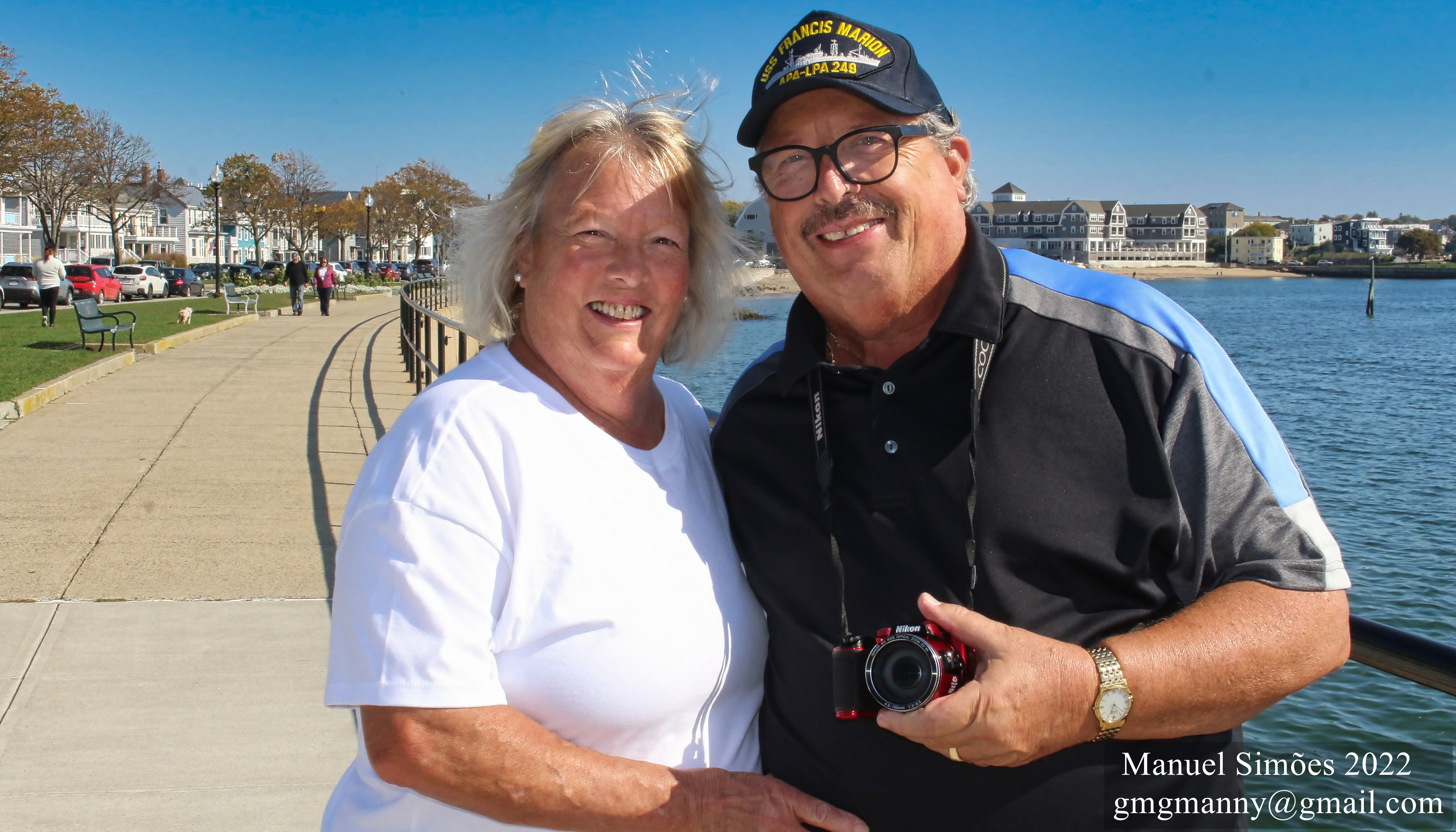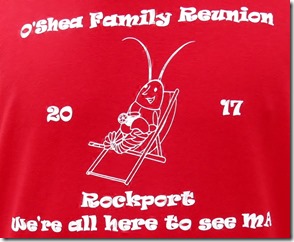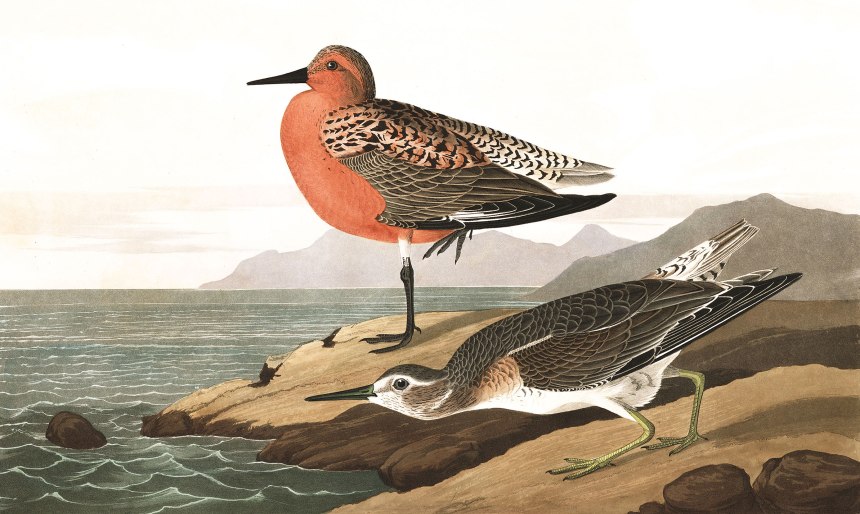
Couple from Cape May New Jersey

My View of Life on the Dock

 A very energetic group from Florida, Ohio, New Jersey, and several other States. The photo below only has a few of the 41 members that embarked on Cape Ann to celebrate with “Ma”, Lillian O’Shea (88) of Rockport Massachusetts. She is the mother of 8 children, 4 boys, 4 girls, which accounts for the large group. Some were wearing their reunion motto for 2017, “Our Family Doesn’t Suffer from Insanity, We Kind of Enjoy It!!”
A very energetic group from Florida, Ohio, New Jersey, and several other States. The photo below only has a few of the 41 members that embarked on Cape Ann to celebrate with “Ma”, Lillian O’Shea (88) of Rockport Massachusetts. She is the mother of 8 children, 4 boys, 4 girls, which accounts for the large group. Some were wearing their reunion motto for 2017, “Our Family Doesn’t Suffer from Insanity, We Kind of Enjoy It!!”
O’Shea Family Reunion
Visitors from New Jersey, celebrating promotion to Police Sergeant (far left).
A Proud father (also a police officer) with friends, were headed to dinner at Latitude 43.
Tomorrow they were all meeting up with David Marciano to go out on the F/V Hard Merchandise.
Drone captures dramatic sinking of the U.S. Coast Guard Cutter Tamaroa, formerly the Navy fleet tug Zuni, at the Del-Jersey-Land Inshore Reef. The reef is located 26 nautical miles southeast of Cape May. (Video by Andre Malok and Craig McCarthy | NJ Advance Media for NJ.com)
By Craig McCarthy | NJ Advance Media for NJ.com
MAY 10, 2017
A famed Coast Guard cutter and former Navy tug has entered its third tour of duty as it now sits 135 feet below sea level off the coast of New Jersey, creating a destination for divers and adding to an already thriving ecosystem of marine life.
The Tamaroa, famously featured in the book and movie “The Perfect Storm” –where its crew saved three from a sailboat caught in the storm and four of five members of the Air National Guard whose helicopter had ran out of fuel– was first commissioned by the U.S. Navy in 1943 as the Zuni and tugged torpedoed ships to safety during the assault on Iwo Jima.
“Now she’ll serve forever,” said Rollie LeDoux, who was stationed on the ship 35 years ago. “It’s sad to see her go, but it’s better than her becoming some beer cans.”
Planning began last summer to scuttle the Tamaroa, which was retired in 1994 after nearly 50 years on the seas. The 205-foot ship began its trip to waters off the Jersey coast Monday night after it was towed to Suffolk, Va., where it was cleaned and prepared for its sinking.
Shortly after 1 p.m. Wednesday, The Tamaroa was on her way to join up with the largest vessel ever deployed on the East Coast, a 563-foot destroyer, in the artificial reef off Cape May Wednesday afternoon.
“It could last for 100 years, creating a marine environment for fisherman and the diving community,” said Peter Clarke, who coordinates the artificial reef program at the state’s Department of Environmental Protection. Clarke said the site where the Tamaroa was sunk has attracted a variety of fish, including mako shark, blue fish and tuna.
“She’ll be serving long after I’m gone,” LeDoux said.
Documentary filmmaker Jared Flesher, “The Red Knot has been on my list since the very beginning,” he says. “As a species, it has all the elements of a dramatic story.” The bird is charismatic and attractive, particularly in its red-breasted summer plumage, and it makes one of the longest annual migrations on Earth, flying up to 9,000 miles each way from the southern tip of South America to the northernmost reaches of the Arctic where the species nests. Every May, as Red Knots make their long trek north, they pause at Delaware Bay in southern New Jersey to refuel, gobbling down the fat-rich horseshoe crab eggs that coat the shore.
At least, that’s what’s supposed to happen. Red Knots already have to overcome numerous challenges on such a long migration, but today they also face new threats. Climate change puts the species’ Arctic nesting sites at risk, and there’s trouble with their main food source at Delaware Bay, where in the early 2000s horseshoe crab over harvesting led to a Red Knot population crash. Since then, the subspecies that migrates through Delaware Bay has been listed under the Endangered Species Act, and the crab harvest has been limited. Red Knots seem to be slowly rebounding, but conservationists are worried that the population is still fragile.
As a storyteller, a species disappearing from earth forever—that’s just about the most dramatic hook there is,” Flesher says. And as he explores in Birds of May, which was partly funded by the Washington Crossing Audubon Society, a new threat may be lurking for the far-flying birds at their New Jersey stopover site.”
See the trailer below and watch the film exclusively at Audubon here only through May 7th.
On the sandy beaches of the Delaware Bay, in New Jersey, a visitor arrives each May from the southernmost tip of South America. Name: Calidris canutus rufa. The rufa red knot.
What makes the red knot remarkable is its epic journey: 19,000 miles per year, from Tierra del Fuego to the Arctic Circle and back again, one of the longest migrations in the animal kingdom.
The Delaware Bay serves as the most important stepping stone during the red knot’s long spring migration. Famished knots, having flown without rest for as many as seven days straight, arrive on the bay having lost half their body weight. For two crucial weeks, the birds gorge on the eggs of horseshoe crabs. Red knots that gain enough weight will survive the final leg of their journey to the Arctic. Others perish.
In 2015, the U.S. Fish & Wildlife Service listed the rufa red knot as a federally threatened species—it faces threats throughout the Western Hemisphere, from habitat loss in South America to the impacts of climate change in the Arctic. The calamitous overharvest of horseshoe crabs on the Delaware Bay last decade was another major driver of the red knot’s decline—when the starving birds arrived, there weren’t enough eggs waiting for them.
Most recently, in 2016, state and federal regulators approved a plan to permit a 1,400 percent increase in oyster farming on the Delaware Bay. The oyster farms operate on the same tidal flats used by hungry red knots at low tide.
Birds of May, filmed in May 2016 on the beaches of the Delaware Bay, is filmmaker Jared Flesher’s ode to the natural spectacle of the red knot’s annual visit. It’s also an investigation of potential new threats to red knot survival. Not everyone is sure that expanded oyster farming and red knots can happily coexist. Against the scenic backdrop of the bay, Flesher interviews both oyster farmers and the shorebird biologists who fear that an oyster farming boom here could push the rufa red knot closer to extinction.
Read more about filmmaker Jared Flesher here:
A tiny shorebird inspires N.J. filmmaker and a flock of poets
This couple are from Little Egg Harbor New Jersey, not to be mistaken with Big Egg Harbor.
Named by the American Indians, because small birds laid their eggs in Little Egg Harbor and Big Birds laid their eggs in Big Egg Harbor.
 Tourists from North Reading, MA, Washington D.C., London England, Long Island New York, New Jersey, and Capt. Pete from Cape Ann Harbor Tours teaching young Londoners’.
Tourists from North Reading, MA, Washington D.C., London England, Long Island New York, New Jersey, and Capt. Pete from Cape Ann Harbor Tours teaching young Londoners’.
Photography b long time GMG FOB Kevin Henry
A visit with New Jersey’s commercial fishermen
for the entire story and pictures Click Here
Annual visitor form Minneapolis, New Jersey, and North Carolina enjoy a meal at Cape Ann Brewery. Great reflection of the harbor.